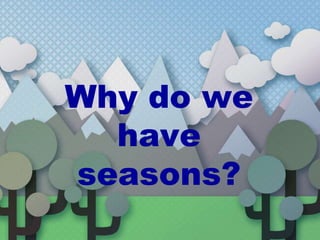
Seasons ppt.pptx
- 2. Earth’s rotation • The Earth rotates on its axis (imaginary vertical line around which Earth spins) every 23 hours & 56 minutes. • One day on Earth is one rotation of the Earth. • Day on Earth is when our side of the Earth faces the sun. • Night on Earth is when the side of Earth we are on faces away from the sun. CLICK ON THIS IMAGE TO VIEW A SHORT VIDEO OF THE EARTH’S ORBIT
- 3. Earth’s revolution • It takes the Earth ~365.25days (or rotations) to travel or revolve around the Sun once. • This is called a year.
- 4. Why do we have seasons? • The Earth’s orbit around the sun is NOT a perfect circle. It is an ellipse. • Seasons are not caused by how close the Earth is to the sun. • In fact, the Earth is closest to the sun around January 3 and farthest away from the sun around July 4.
- 5. Why do we have seasons? • Seasons are the result of the tilt of the Earth's axis. • Earth’s axis is tilted 23.5°. • This tilting is why we have SEASONS like fall, winter, spring, summer. • The number of daylight hours is greater for the hemisphere, or half of Earth, that is tilted toward the Sun.
- 6. Why do we have seasons? • Summer is warmer than winter (in each hemisphere) because the Sun's rays hit the Earth at a more direct angle during summer than during winter
- 7. Why do we have seasons? • Also the days are much longer than the nights during the summer. • During the winter, the Sun's rays hit the Earth at an extreme angle, and the days are very short. These effects are due to the tilt of the Earth's axis.
- 8. Seasons…in a nut shell
- 9. Solstices • Solstices occur twice a year, when the tilt of the Earth's axis is oriented directly towards or away from the Sun, causing the Sun to appear to reach its northernmost and southernmost extremes. • Winter solstice is the shortest day of the year. In the Northern Hemisphere. It occurs on December 21 and marks the beginning of winter. • The Summer Solstice is the longest day of the year. It occurs on June 21 and marks the beginning of summer. Tyrrhenian Sea and Solstice Sky Credit & Copyright: Danilo Pivato
- 10. SOLSTICE • During the winter the Northern Hemisphere day lasts fewer than 12 hours and the Southern Hemisphere day lasts more than 12 hours. • During the winter solstice, the North Pole has a 24-hour night and the South Pole has a 24-hour day. • Sunlight strikes the earth most directly at the Tropic of Capricorn. C.LICK ON THE ANIMATION FOR A SHORT VIDEO ON SOLSTICES FROM NATIONAL GEOGRAPHIC
- 11. Notice that the Sun’s angle is greater in the summer and is higher in the sky, and it has a lower angle and it is lower in the winter sky. SUN’S ANGLE DURING SOLSTICES
- 12. Equinoxes • A day lasts 12 hours and a night lasts 12 hours at all latitudes. • Equinox literally means "equal night". • Sunlight strikes the earth most directly at the equator. • This occurs twice a year. C.LICK ON THE ANIMATION FOR A SHORT VIDEO ON EQUINOXES FROM NATIONAL GEOGRAPHIC
- 13. Equinox • The vernal (spring) equinox occurs usually March 20th. • The autumnal (fall) equinox occurs • usually September 22nd.
- 14. The Earth's seasons are not caused by the differences in the distance from the Sun throughout the year.
- 15. The seasons are the result of the tilt of the Earth's axis. I know this is a repeat, but it is important that you understand this idea. Many Americans, including Harvard graduates, do not know what causes seasons!
- 16. Review Look closely at where the Sun is hitting the Earth during each season: https://www.learner.org/jnorth/tm/mclass/sl/6/index.html
- 17. http://www.nmm.ac.uk/uploads/gif/seasons-full.gif When does the Earth(in the northern hemisphere) receive the greatest amount of direct energy from the sun? When does it receive the least amount of energy?